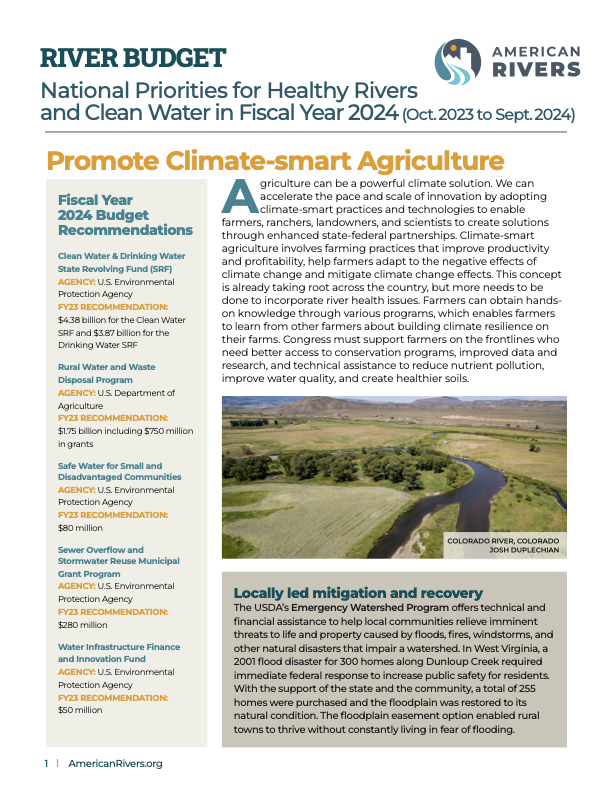River Budget: National Priorities for Healthy Rivers and Clean Water (FY24)

Water flowing in our streams, rivers, and creeks is a precious resource: It comprises two-thirds of our drinking water and is critical to the health of our communities. Rivers also serve as critical habitats for fish and wildlife. Plus, rivers sustain our economies, connect our communities to nature, and buffer our cities and towns against the worst impacts of climate change. Tragically, many rivers nationwide are polluted, dammed, and degraded, and most of the nation’s water infrastructure is in a state of disrepair.
With recent investments from the bipartisan infrastructure law and the Inflation Reduction Act, now is the time to ensure these much-needed funds are directed to clean water and river restoration projects that improve the lives and climate resiliency of people in rural and urban areas — and particularly Communities of Color and Tribal Nations, who are disproportionately impacted by water pollution, droughts, floods, and environmental degradation.
We must ensure federal agencies have the tools, resources, technical assistance, and capacity they need to solve today’s complex water challenges. Federal investment in efforts including natural infrastructure and river restoration can make rivers healthier and water cleaner for everyone.
The Fiscal Year 2024 River Budget outlines recommended federal priorities for agencies, including the Department of Interior, Department of Agriculture, National Oceanic and Atmospheric Administration, and Environmental Protection Agency, to promote climate-smart agriculture practices, improve water infrastructure, restore watersheds, modernize flood management, and support dam removal and rehabilitation. The River Budget spotlights needs in five key categories:
Promote climate-smart agriculture: Innovative conservation practices on farms and working lands can regenerate ecosystems, improve irrigation, and bolster agriculture. Yet water shortages are becoming increasingly common due to less rainfall, resulting in historic droughts. In 2022, the Mississippi River dropped to record-low water levels. In the Southwest, farmers, ranchers, and landowners are experiencing the most extreme drought in more than a millennium. In the Fiscal Year 2024 appropriations process and upcoming Farm Bill, Congress and the Administration must prioritize climate-smart agriculture to support rural communities, and a critical sector of our economy.
Restore watersheds: From the Great Lakes to the Chesapeake Bay, watersheds are essential to keeping ecosystems healthy and functioning as nature intended. These lands naturally store water, filter pollution, sequester carbon, control erosion and sediment, and provide habitats for wildlife. These natural services help strengthen communities in the face of climate change, and can buffer us against severe floods, droughts, and fires. Healthy watersheds also provide recreation benefits, including fishing, boating, swimming, hiking, biking, and wildlife watching. In 2020, hunters and anglers contributed $149 billion to the national economy, supported 970,000 jobs, and created over $45 billion in wages and incomes.
Modernize flood management: Inland and coastal communities need relief as environmental pressures and natural disasters including hurricanes and floods, threaten people and property. Nearly 41 million people live in flood-prone areas. Our nation needs to continue investing in flood-management solutions that protect communities and safeguard rivers. We call on Congress and the Administration to implement nature-based solutions to managing watersheds, floodplains, wetlands, and other water sources. This includes better coordination-mapping technology to produce maps that inform communities about flood risk and help them better prepare for extreme weather.
Improve water infrastructure: Our nation’s water infrastructure is essential to providing safe, reliable, affordable clean water. It is vital to public health, and to ensuring clean, healthy rivers. Every dollar invested in water infrastructure generates $2.20 in economic activity. Yet decades of underfunded and deferred maintenance has pushed the nation’s water infrastructure to the brink of collapse. Many cities hold, treat, and deliver water using pumps and pipes that are more than 100 years old. Older water systems contain bacteria, lead, and other hazardous chemicals, which exposed thousands to untreated water in Flint, Michigan, and Jackson, Mississippi. We must avoid humanitarian disasters by securing significant water infrastructure investments that protect the health of people and rivers.
Remove and rehabilitate dams: Removing dams and improving dam safety can restore natural functions of rivers, help fish and wildlife species recover, create jobs, and increase our communities’ resilience to droughts and floods. Dams disrupt the natural ecosystem by impacting water quality, cutting off migration routes, isolating habitats, and destroying fish spawning grounds. Some dams pose serious public safety risks. Prioritizing funding to remove, rehabilitate, and/or retrofit dams is the best way to bring life back to damaged rivers and protect communities.
These federal spending priorities in the Fiscal Year 2024 River Budget are a critical defense against the impacts of climate change and water pollution. The annual federal spending process charges Congress to work with the administration and focus on investments that are key to restoring rivers, from remote mountain streams to urban waterways. Taken together, these investments will improve public health and safety, boost climate resilience, deliver economic benefits, and improve agency programs that are responsible and responsive to meeting community needs.
For questions, contact:
Jaime D. Sigaran, Associate Director, Policy and Government Relations
jsigaran@americanrivers.org
Ted Illston, Vice President, Policy and Government Relations
tillston@americanrivers.org

